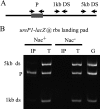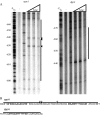Expanded role for the nitrogen assimilation control protein in the response of Klebsiella pneumoniae to nitrogen stress
- PMID: 20348267
- PMCID: PMC2944540
- DOI: 10.1128/JB.00931-09
Expanded role for the nitrogen assimilation control protein in the response of Klebsiella pneumoniae to nitrogen stress
Abstract
Klebsiella pneumoniae is able to utilize many nitrogen sources, and the utilization of some of these nitrogen sources is dependent on the nitrogen assimilation control (NAC) protein. Seven NAC-regulated promoters have been characterized in K. pneumoniae, and nine NAC-regulated promoters have been found by microarray analysis in Escherichia coli. So far, all characterized NAC-regulated promoters have been directly related to nitrogen metabolism. We have used a genome-wide analysis of NAC binding under nitrogen limitation to identify the regions of the chromosome associated with NAC in K. pneumoniae. We found NAC associated with 99 unique regions of the chromosome under nitrogen limitation. In vitro, 84 of the 99 regions associate strongly enough with purified NAC to produce a shifted band by electrophoretic mobility shift assay. Primer extension analysis of the mRNA from genes associated with 17 of the fragments demonstrated that at least one gene associated with each fragment was NAC regulated under nitrogen limitation. The large size of the NAC regulon in K. pneumoniae indicates that NAC plays a larger role in the nitrogen stress response than it does in E. coli. Although a majority of the genes with identifiable functions that associated with NAC under nitrogen limitation are involved in nitrogen metabolism, smaller subsets are associated with carbon and energy acquisition (18 genes), and growth rate control (10 genes). This suggests an expanded role for NAC regulation during the nitrogen stress response, where NAC not only regulates genes involved in nitrogen metabolism but also regulates genes involved in balancing carbon and nitrogen pools and growth rate.
Figures




Similar articles
-
A NAC for regulating metabolism: the nitrogen assimilation control protein (NAC) from Klebsiella pneumoniae.J Bacteriol. 2010 Oct;192(19):4801-11. doi: 10.1128/JB.00266-10. Epub 2010 Jul 30. J Bacteriol. 2010. PMID: 20675498 Free PMC article. Review.
-
Genetic analysis of the nitrogen assimilation control protein from Klebsiella pneumoniae.J Bacteriol. 2010 Oct;192(19):4834-46. doi: 10.1128/JB.01114-09. Epub 2010 Aug 6. J Bacteriol. 2010. PMID: 20693327 Free PMC article.
-
Importance of tetramer formation by the nitrogen assimilation control protein for strong repression of glutamate dehydrogenase formation in Klebsiella pneumoniae.J Bacteriol. 2005 Dec;187(24):8291-9. doi: 10.1128/JB.187.24.8291-8299.2005. J Bacteriol. 2005. PMID: 16321933 Free PMC article.
-
The role of the NAC protein in the nitrogen regulation of Klebsiella aerogenes.Mol Microbiol. 1991 Nov;5(11):2575-80. doi: 10.1111/j.1365-2958.1991.tb01965.x. Mol Microbiol. 1991. PMID: 1664020 Review.
-
Properties of the NAC (nitrogen assimilation control protein)-binding site within the ureD promoter of Klebsiella pneumoniae.J Bacteriol. 2010 Oct;192(19):4821-6. doi: 10.1128/JB.00883-09. Epub 2010 Jul 9. J Bacteriol. 2010. PMID: 20622063 Free PMC article.
Cited by
-
A NAC for regulating metabolism: the nitrogen assimilation control protein (NAC) from Klebsiella pneumoniae.J Bacteriol. 2010 Oct;192(19):4801-11. doi: 10.1128/JB.00266-10. Epub 2010 Jul 30. J Bacteriol. 2010. PMID: 20675498 Free PMC article. Review.
-
Transcriptional regulation of the gene cluster encoding allantoinase and guanine deaminase in Klebsiella pneumoniae.J Bacteriol. 2011 May;193(9):2197-207. doi: 10.1128/JB.01450-10. Epub 2011 Feb 25. J Bacteriol. 2011. PMID: 21357483 Free PMC article.
-
Nitrogen assimilation in Escherichia coli: putting molecular data into a systems perspective.Microbiol Mol Biol Rev. 2013 Dec;77(4):628-95. doi: 10.1128/MMBR.00025-13. Microbiol Mol Biol Rev. 2013. PMID: 24296575 Free PMC article. Review.
-
Genetic analysis of the nitrogen assimilation control protein from Klebsiella pneumoniae.J Bacteriol. 2010 Oct;192(19):4834-46. doi: 10.1128/JB.01114-09. Epub 2010 Aug 6. J Bacteriol. 2010. PMID: 20693327 Free PMC article.
-
Preliminary study on the role of novel LysR family gene kp05372 in Klebsiella pneumoniae of forest musk deer.J Zhejiang Univ Sci B. 2020 Feb.;21(2):137-154. doi: 10.1631/jzus.B1900440. Epub 2020 Feb 5. J Zhejiang Univ Sci B. 2020. PMID: 32115911 Free PMC article.
References
-
- Bencini, D. A., G. A. O'Donovan, and J. R. Wild. 1984. Rapid chemical degradation sequencing. Biotechniques 2:4-5.
-
- Bender, R. A. 1991. The role of the NAC protein in the nitrogen regulation of Klebsiella aerogenes. Mol. Microbiol. 5:2575-2580. - PubMed
Publication types
MeSH terms
Substances
Grants and funding
LinkOut - more resources
Full Text Sources

